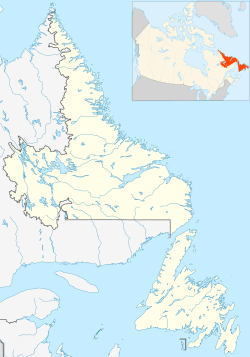Burlington, Newfoundland and Labrador
Burlington | |
|---|---|
Town | |
| Coordinates: 49°45′01″N 56°01′03″W / 49.75028°N 56.01750°W[1] | |
| Country | Canada |
| Province | Newfoundland and Labrador |
| Government | |
| • Mayor | Rudy Norman |
| Area | |
• Total | 4.11 km2 (1.59 sq mi) |
| Elevation | 3 m (10 ft) |
| Population (2021) | |
• Total | 304 |
| • Density | 74/km2 (190/sq mi) |
| Time zone | UTC-3:30 (Newfoundland Time) |
| • Summer (DST) | UTC-2:30 (Newfoundland Time) |
| Postal Code | |
| Area code | Area code 709 |
| Highways | |
| Website | townofburlington |
Burlington is an incorporated town in Newfoundland and Labrador, Canada.[1] It is a small fishing and lumbering community on Route 413 at the north side of the mouth of Green Bay. Burlington is located approximately 40 km from Baie Verte.
History
[edit]Burlington was once named Northwest Arm, and was permanently settled in the mid-19th century. The community was renamed in the early part of 1915 due to a mix-up in the mail service. After many residents complained that their mail was sent to another community with a similar name, the town leaders felt the need to have a name change. Out of three separate entries, 'Burlington' was chosen.
There was no large industry in the 19th century. The early settlers fished for cod and cleared land to grow potatoes, cabbage and small fruits. Keeping animals provided meat for the winter and milk and butter in season. Settlers built their own boats for fishing in Labrador, or they were employed by the inshore fishery. When mines opened at both Bett's Cove and Tilt Cove, some of the Burlington men went to both communities for work.
Logging pitprops for the United Kingdom were started in 1915 by a contractor named John Jennings. This industry was closed in 1918 when the sale of pitprops ended. Lumber camps opened in 1920, but closed during the Depression of the 1930s. In 1935, the Thistle family started cutting export wood. They remained a major economic force in Burlington for approximately 30 years. Camps later opened for the cutting of pulpwood and continued for about ten years. In 1969 pulpwood was again the main industry, shipped out by truck from Burlington.
Language
[edit]According to the 2021 census, 100% of Burlington's population speaks English, with the census also stating that 100% of the population only know how to speak English.[3] Burlington and surrounding area has a distinct dialect that is still heard by many today, because of its English and Irish heritage.[citation needed]
Demographics
[edit]| Year | Pop. | ±% |
|---|---|---|
| 1996 | 432 | — |
| 2001 | 409 | −5.3% |
| 2006 | 376 | −8.1% |
| 2011 | 349 | −7.2% |
| 2016 | 314 | −10.0% |
| 2021 | 304 | −3.2% |
| Source: [3] | ||
In the 2021 Census of Population conducted by Statistics Canada, Burlington had a population of 304 living in 119 of its 135 total private dwellings, a change of -3.2% from its 2016 population of 314. With a land area of 4.09 km2 (1.58 sq mi), it had a population density of 74.3/km2 (192.5/sq mi) in 2021.[3]
| 2021 | 2016 | 2011 | |
|---|---|---|---|
| Population | 304 (-3.2% from 2016) | 314 (-10.0% from 2011) | 349 (-7.2% from 2006) |
| Land area | 4.09 km2 (1.58 sq mi) | 4.1 km2 (1.6 sq mi) | 4.1 km2 (1.6 sq mi) |
| Population density | 74.3/km2 (192/sq mi) | 76.7/km2 (199/sq mi) | 85.2/km2 (221/sq mi) |
| Median age | 52.0 (M: 53.2, F: 51.2) | 43.2 (M: 43.4, F: 43.0) | 43.6 (M: 44.4, F: 42.3) |
| Private dwellings | 135 (total) 119 (occupied) | 120 (total) | 137 (total) |
| Median household income | $76,500 |
Notable residents
[edit]Towns and communities nearby
[edit]- Middle Arm
- Smith's Harbour
- Baie Verte
- Springdale
- Kings Island
See also
[edit]References
[edit]- ^ a b "Burlington". Geographical Names Data Base. Natural Resources Canada. Retrieved 2014-08-14.
- ^ Taken from Google Earth at geographic coordinates, accessed 2014-08-14.
- ^ a b c "Population and dwelling counts: Canada, provinces and territories, census divisions and census subdivisions (municipalities), Newfoundland and Labrador". Statistics Canada. February 9, 2022. Retrieved March 15, 2022.
- ^ "2021 Community Profiles". 2021 Canadian census. Statistics Canada. February 4, 2022. Retrieved 2023-10-19.
- ^ "2016 Community Profiles". 2016 Canadian census. Statistics Canada. August 12, 2021. Retrieved June 16, 2017.
- ^ "2011 Community Profiles". 2011 Canadian census. Statistics Canada. March 21, 2019. Retrieved August 14, 2014.

